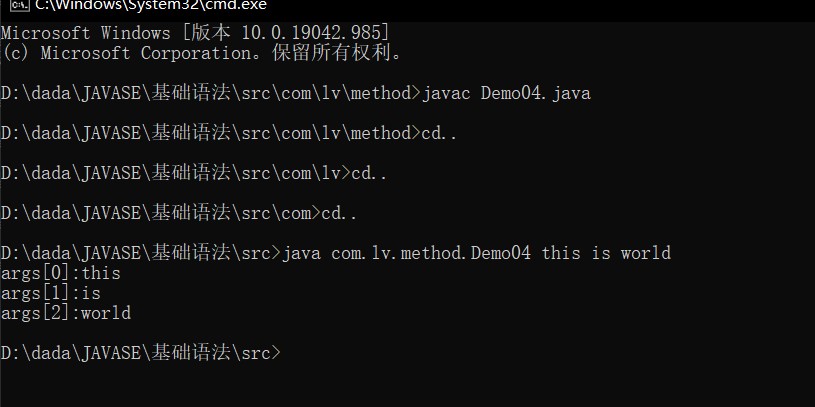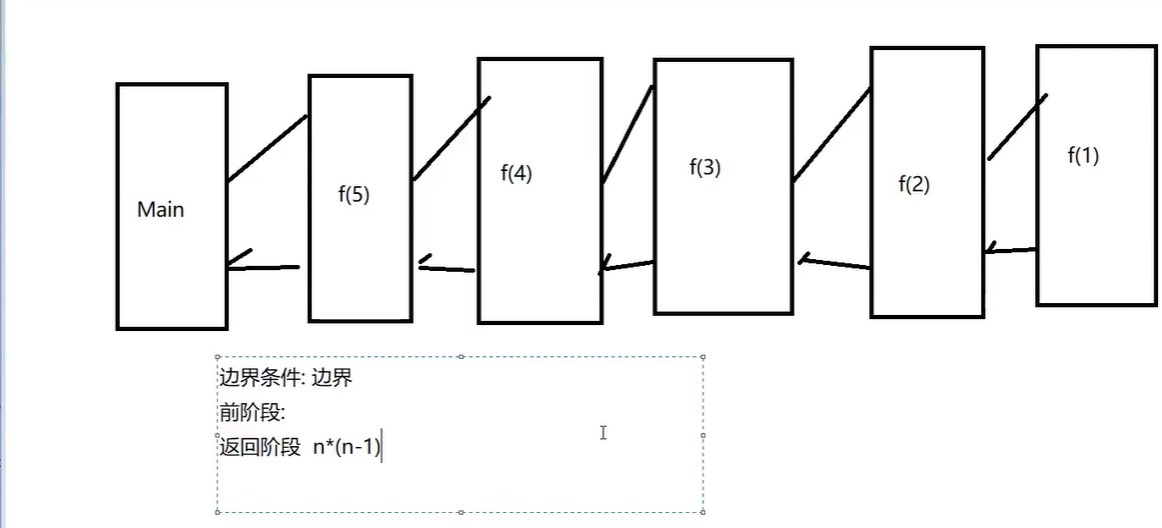java方法详解
java方法详解
一、何为方法?
- System.out.println(),那么他是什么呢?
? 调用系统类里面的标准输出对象out中的方法叫做 println方法
-
java方法是语句的集合,它们在一起执行一个功能。
1.方法是解决一类问题的步骤的有序组合
2.方法包含与类或对象中
3.方法在程序中,在其他地方被引用
package com.lv.method; public class Demo01 { //main方法 //实参:调用方法时实际传给方法的数据。 public static void main(String[] args) { int sum = add(1, 2); System.out.println(sum); } //加法 //形式参数:在方法被调用时用于接收外界输入的数据。 public static int add(int a,int b){ return a+b; } }
结果:3
- 设计方法的本意是功能块,就是实现某个功能的语句块的集合。我们设计方法的时候,最好保持方法的原子性,就是一个方法只完成1个功能,这样利于我们后期的扩展。
package com.lv.method;
public class Demo02 {
public static void main(String[] args) {
test();
}
public static void test(){
for (int i = 0; i <=1000; i++) {
if(i%5==0){
System.out.print(i+" ");
}
if (i%(5*3)==0){
System.out.println();
}
}
}
}
结果:
0
5 10 15
20 25 30
35 40 45
50 55 60
65 70 75
80 85 90
95 100 105
110 115 120
125 130 135
140 145 150
155 160 165
170 175 180
185 190 195
200 205 210
215 220 225
230 235 240
245 250 255
260 265 270
275 280 285
290 295 300
305 310 315
320 325 330
335 340 345
350 355 360
365 370 375
380 385 390
395 400 405
410 415 420
425 430 435
440 445 450
455 460 465
470 475 480
485 490 495
500 505 510
515 520 525
530 535 540
545 550 555
560 565 570
575 580 585
590 595 600
605 610 615
620 625 630
635 640 645
650 655 660
665 670 675
680 685 690
695 700 705
710 715 720
725 730 735
740 745 750
755 760 765
770 775 780
785 790 795
800 805 810
815 820 825
830 835 840
845 850 855
860 865 870
875 880 885
890 895 900
905 910 915
920 925 930
935 940 945
950 955 960
965 970 975
980 985 990
995 1000
二、方法的定义
- java的方法类似于其他语言的函数,是一段用来完成特定功能的代码片段,一般情况下,定义一个方法包含以下语法:
? 方法包含一个方法头和一个方法体。下面是一个方法的所有部分:
? 1.修饰符:修饰符,这是可选的,告诉编译器如何调用该方法。定义了该方法的访问类型。
2. 方法可能会返回值。returnValueType是方法返回值的数据类型。有些方法执行所需,但没有返回值。在这种情况下,returnValueType是关键字void。
3. 方法名:是方法的实际名称。方法名和参数表共同构成方法签名。
4. 参数类型:参数像是一个占位符。当方法被调用时,传递值给参数。这个值被称为实参或变量。参数列表是指方法的参数类型、顺序和参数的个数。参数是可选的,方法可以不包含任何参数。
? (1)形式参数:在方法被调用时用于接收外界输入的数据。
? (2)实参:调用方法时实际传给方法的数据。
- 方法体:方法体包含具体的语句,定义该方法的
修饰符 返回值类型 方法名(参数类型 参数名){
...
方法体
...
return 返回值;
}
方法调用
- 调用方法:对象名.方法名(实参列表)
- java支持两种调用方法的方式,根据方法是否返回值来选择。
- 当方法返回一个值的时候,方法调用通常被当作一个值。例如:
int large = max(30,40);
- 如果方法返回值是void,方法调用一定是一条语句。
System.out.println("Hello,World!")
package com.lv.method;
public class Demo03 {
public static void main(String[] args) {
int max = max(10, 20);
System.out.println(max);
}
//比大小
public static int max(int num1,int num2 ){
int resout = 0;
if (num1==num2){
System.out.println("num1==num2");
return 0;
}
if (num1>num2){
resout = num1;
return resout;
}
else {
resout = num2;
return resout;
}
}
}
结果: 20
三、方法的重载
- 重载就是在一个类中,有相同的函数名称,但形参不同的函数
- 方法的重载的规则:
- 方法名称必须相同。
- 参数列表必须不同(个数不同、或类型不同、参数排列顺序不同等)。
- 方法的返回类型可以相同也可以不同。
- 仅仅返回类型不同不足以成为方法的重载。
package com.lv.method;
public class Demo03 {
public static void main(String[] args) {
double max = max(10.0, 10.1);
System.out.println(max);
}
//比大小
public static double max(double num1,double num2 ) {
double resout = 0;
if (num1 == num2) {
System.out.println("num1==num2");
return 0;
}
if (num1 > num2) {
resout = num1;
return resout;
} else {
resout = num2;
return resout;
}
}
//比大小
public static int max(int num1,int num2 ){
int resout = 0;
if (num1==num2){
System.out.println("num1==num2");
return 0;
}
if (num1>num2){
resout = num1;
return resout;
}
else {
resout = num2;
return resout;
}
}
}
结果:10.1
- 实现理论:
方法名称相同时,编译器会根据调用方法的参数个数、参数类型等去逐个匹配,以选择对应得方法,如果匹配失败,则编译器报错。
四、命令行传参
- 有时候你希望运行一个程序时候再传递给它消息。这要靠传递命令行参数给main()函数实现。
public class CommandLine{
public static void main(String arge[]){
for(int i =0; i<args.lengt;i++){
System.out.println("args["+i+"]:"+args[i]);
}
}
}
1.打开储存代码的文件夹

2.在此打开cmd,并输入

五、可变参数
- JDK 1.5开始,java支持传递同类型的可变参数给一个方法。
- 在方法声明中,在指定参数类型后加一个省略号(...)。
package com.lv.method;
public class Demo05 {
public static void main(String[] args) {
Demo05 demo05 = new Demo05();
demo05.test(1,2,3,4,5);
}
public void test(int...i){
System.out.println(i[0]);
System.out.println(i[1]);
System.out.println(i[2]);
System.out.println(i[3]);
System.out.println(i[4]);
}
}
结果:
1
2
3
4
5
- 一个方法中只能指定一个可变参数,它必须是方法定的最后一个参数。任何普通的参数必须在它之前声明。
package com.lv.method;
public class Demo06 {
public static void main(String[] args) {
printmax(34,54,60.4,8);
printmax(new double[]{1,2,3});
}
public static void printmax(double...numbers){
if(numbers.length == 0){
System.out.println("No argument passed");
return;
}
double result = numbers[0];
for(int i =1;i<numbers.length;i++){
if(numbers[i]>result){
result=numbers[i];
}
}
System.out.println("The max value is:"+result);
}
}
结果:
The max value is:60.4
The max value is:3.0
六、递归
- A方法调用B方法,我们很容易理解
- 递归:A方法调用A方法!就是自己调用自己
- 利用递归可以用简单的程序来解决一些复杂的问题。它通常把一个大型复杂的问题层层转化为一个与原问题相似的规模较小的问题来求解,递归策略只需少量的程序就可描述出解题过程所需要的多次重复计算,大大地减少了程序的代码量。递归的能力在于用有限的语句来定义对象的无限合集。
- 递归结构包括两个部分:
- 递归头:什么时候不调用自身方法。如果没有头,将陷入死循环。
- 递归体:什么时候需要调用自身方法。
package com.lv.method;
public class Demo07 {
public static void main(String[] args) {
System.out.println(f(5));
}
//1! 1
//2! 2*1
//5! 5*4*3*2*1
//2 2*f(1)
//3 3*f(2)
public static int f(int n) {
if (n == 1) {
return 1;
} else {
return n * f(n - 1) ;
}
}
}
结果:120
原理:

